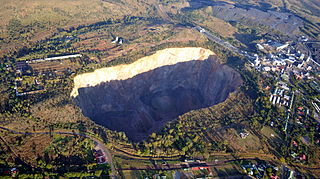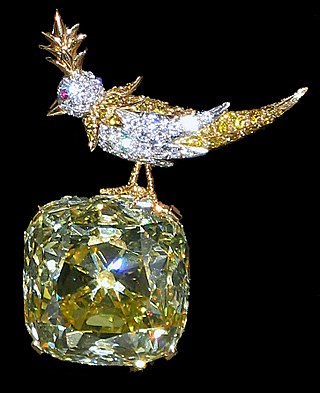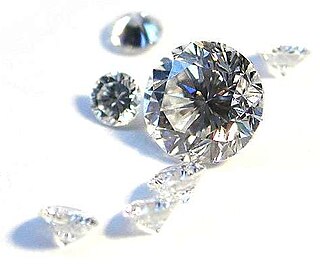
Diamond is a solid form of the element carbon with its atoms arranged in a crystal structure called diamond cubic. Another solid form of carbon known as graphite is the chemically stable form of carbon at room temperature and pressure, but diamond is metastable and converts to it at a negligible rate under those conditions. Diamond has the highest hardness and thermal conductivity of any natural material, properties that are used in major industrial applications such as cutting and polishing tools. They are also the reason that diamond anvil cells can subject materials to pressures found deep in the Earth.

A gemstone is a piece of mineral crystal which, when cut or polished, is used to make jewelry or other adornments. Certain rocks and occasionally organic materials that are not minerals may also be used for jewelry and are therefore often considered to be gemstones as well. Most gemstones are hard, but some softer minerals such as brazilianite may be used in jewelry because of their color or luster or other physical properties that have aesthetic value. However, generally speaking, soft minerals are not typically used as gemstones by virtue of their brittleness and lack of durability.
Diamond cutting is the practice of shaping a diamond from a rough stone into a faceted gem. Cutting diamonds requires specialized knowledge, tools, equipment, and techniques because of its extreme difficulty.
A golden jubilee marks a 50th anniversary. It variously is applied to people, events, and nations.

The Cullinan Diamond is the largest gem-quality rough diamond ever found, weighing 3,106 carats (621.20 g), discovered at the Premier No.2 mine in Cullinan, South Africa, on 26 January 1905. It was named after Thomas Cullinan, the owner of the mine. In April 1905, it was put on sale in London, but despite considerable interest, it was still unsold after two years. In 1907, the Transvaal Colony government bought the Cullinan and Prime Minister Louis Botha presented it to Edward VII, the British king who reigned over the territory, and it was cut by Joseph Asscher & Co. in Amsterdam.

A diamond cut is a style or design guide used when shaping a diamond for polishing such as the brilliant cut. Cut refers to shape, and also the symmetry, proportioning and polish of a diamond. The cut of a diamond greatly affects a diamond's brilliance—a poorly-cut diamond is less luminous.
The De Beers Centenary Diamond is, at 273.85 carats (54.770 g), the third-largest diamond to have been produced in the Premier Mine. Among top-color diamonds, only the Cullinan I and II are larger than the Centenary diamond. The Centenary Diamond is rated in color as grade D color by the Gemological Institute of America, which is the highest grade of colourless diamond and is internally and externally flawless. It was named the Centenary Diamond as it was presented in the rough for the Centennial Celebration of De Beers Consolidated Mines on 11 May 1988. The Centenary Diamond was unveiled in final form in May 1991.

The Excelsior Diamond is a gem-quality diamond, and was the largest known diamond in the world from the time of its discovery in 1893 until 1905, when the Cullinan Diamond was found. It was found on June 30, 1893, at the Jagersfontein Mine in South Africa, 130 kilometres south east of Kimberley whose fame as a diamond mining center always overshadowed that of Jagersfontein. It had a blue-white tint and weighed 971 old carats or 995.2 metric carats. The Excelsior rates as the fourth largest rough diamond of gem quality ever found. It was ultimately cut into ten stones weighing from 13 to 68 carats.

The Jubilee Diamond, originally known as the Reitz Diamond is a colourless, cushion-shaped diamond weighing 245.35 carats, making it the sixth largest diamond in the world. It was originally named after Francis William Reitz, the then president of the Orange Free State where the stone was discovered, before being renamed to honour the 60th anniversary of the coronation of Queen Victoria in 1897.

The Premier Mine is an underground diamond mine owned by Petra Diamonds in the town of Cullinan, 40 kilometres (25 mi) east of Pretoria, Gauteng Province, South Africa. Established in 1902, it was renamed the Cullinan Diamond Mine in November 2003 in celebration of its centenary. The mine is a carrot-shaped volcanic pipe and has a surface area of 32 hectares. The mine rose to prominence in 1905, when the Cullinan Diamond – the largest rough diamond of gem quality ever found – was discovered there.

The Royal Asscher Diamond Company was founded in 1854 by the Asscher family of gemcutters. The company is responsible for cutting some of the most famous diamonds in the world including the 2nd largest diamond ever found. Its headquarters still stand at its original location Tolstraat 127 in Amsterdam, the Netherlands. The company also has regional headquarters in New York City and Tokyo.

The Premier Rose Diamond was one of the large rare gems produced by Premier Mine, of De Beers in South Africa.

The Sixtieth Anniversary Celebrations of King Bhumibol Adulyadej's Accession to the Throne were the celebrations held throughout Thailand in 2006 to celebrate King Bhumibol Adulyadej's 60 years on the throne. The celebrations were arranged by the Royal Thai Government with Thaksin Shinawatra as Prime Minister, and joined by representatives of other monarchies.

The Tiffany Yellow Diamond is one of the largest yellow diamonds ever discovered. Its carat weight was originally 287.42 carats in the rough when discovered in 1878 in the Kimberley mine in South Africa. It was cut into a cushion shape of 128.54 carats with 82 facets—24 more than a traditional round brilliant—to maximize its brilliance. The facet pattern features eight needle-like facets pointing outward from the culet (bottom) facet. Jewelry and diamond historian Herbert Tillander refers to this as a "stellar brilliant cut", and lists the gem in his book, Diamond Cuts in Historic Jewelry – 1381 to 1910 (1995), among other such diamonds: the Cullinan Diamond, the Koh-i-Noor, the Polar Star, the Wittelsbach, and others.
Gabriel S. Tolkowsky was a Belgian diamond cutter. He was known for cutting the famous Centenary Diamond, and was one of the world's most renowned diamond cutters. The great nephew of Marcel Tolkowsky, father of the modern round brilliant diamond cut, he is the sixth generation in his family to become well-known in the diamond cutting trade.

Diamond is one of the best-known and most sought-after gemstones. They have been used as decorative items since ancient times.

Petra Diamonds Ltd is a diamond mining group headquartered in Jersey. Petra own one of the world's most productive mines historically, the Cullinan Diamond Mine is famed for having produced the world's largest rough and polished diamond. The company is listed on the London Stock Exchange.

The Wittelsbach-Graff Diamond is a 31.06-carat (6.212 g) deep-blue diamond with internally flawless clarity, originating in the Kollur Mine, India. Laurence Graff purchased the Wittelsbach Diamond in 2008 for £16.4 million. In 2010, Graff revealed he had had the diamond cut by three diamond cutters to remove flaws. The diamond was now more than 4 carats (800 mg) lighter and was renamed the Wittelsbach-Graff Diamond. There is controversy, as critics claim the recutting has so altered the diamond as to make it unrecognisable, compromising its historical integrity.

Brown diamonds are the most common color variety of natural diamonds. In most mines, brown diamonds account for 15% of production. The brown color makes them less attractive to some people as gemstones, and most are used for industrial purposes. However, improved marketing programs, especially in Australia and the United States, have resulted in brown diamonds becoming valued as gemstones and even referred to as chocolate diamonds.
Henry Ho is a jeweler in Thailand and President of the Bangkok Diamond & Precious Stones Exchange.















